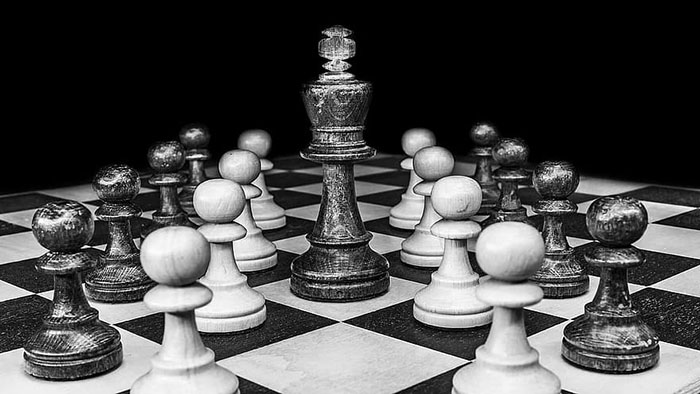Today I want to explain you the rules of one of the most famous and oldest games on this planet. The game is over 1500 years old and still has many fans and tournaments, its Chess. Even though there are more possible moves in a chess game (10^123) then atoms in the universe (10^82), the rules are quite easy to learn.
So, let’s start with the basics of the game:
1: Chess is a board-game where two persons play against each other.
2: Every player has 16 pieces and can move one of them, if it is his or her turn.
3: The Chessboard is 8 fields long and 8 fields big and has with that 64 squares in total.
4: White starts with the first move, then its black turn, then whites again and so on.
5: The goal of the game is to checkmate the opponents King, when one King gets checkmated the game is instantly over.
6: A figure can’t move outside the board or leave the board to come out on the other side.
7: By moving your own figure on a field where your opponent has one, you capture it, which means that you remove that piece of your opponent from the board.
8: You are not allowed to capture your own pieces.
At this point you already know the basic concept of the game. Let’s get deeper into the game and get to know the different pieces better.

In the picture above are already all the different pieces that you will find on a chessboard in black and white.
From the left side the first one is the King, the most important figure. If you lose him you will lose the game. Both players have one King.
The second one is the Queen, she is the most powerful figure in the game. She has a strength of 9 points and every player has just one of her.
The third figure is the Bishop, it has a strength of 3 points and both players have two of them.
The fourth figure is the Knight, he is also worth 3 points and both players have two of them too.
The fifth figure is the Rook, he has a strength of 5 points and both players have two of them.
The last figure in the picture is the Pawn. He only has a strength of 1 point but each player has eight of them.
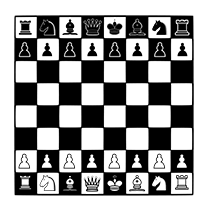
In this picture you can see where you should place the pieces at the beginning of the match. It is important to remember this position because it is always the same one.
It’s an animated picture and the figures are more like symbols for real pieces, however the constellation is the same. At this point you already know the basic concept of the game, the pieces and their worth and the place where you should place them at the beginning. The last part you need to know to start a chess game, is how each figure moves. In the following explanations I will give you a quick overview.
The Rock:
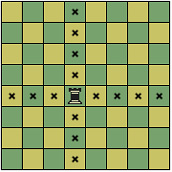
The Rook can move straight in a line horizontally or vertically. He can’t jump over pieces that are on his way, so if one of your own pieces is on the way, he gets blocked. If it’s a piece of your opponent you have the opportunity to capture it, which again means that you take that figure out of the game and place your own on the field where the other one was. Last thing you need to know about the Rooks is that you can chose the direction you want it to go and you don’t have to capture a piece of your opponent.
The Bishop:
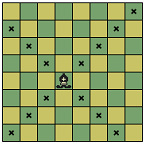
The good thing about learning Bishop is that the same rules apply as for the Rook. The only difference is that it moves on the diagonals. One on the white diagonals and one on the black.
The Queen:
For the legal moves of the queen you just need to remember that she can move as a rook or as a Bishop. You can think about which way of moving her is more profitable for you. So, you can check out the Rook and the Bishop again to see how the queen can move.
The Knight (Horse):
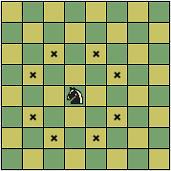
The Knight is a very special figure in the way it moves and probably the toughest one to learn. It can go two up or down and then one to the left or right and also two to the left or right and then one up or down. However, most of the time there aren’t that many options for the knight because some fields are blocked by your own pieces and you also can’t move it outside the board.
The King:
The way the King moves is easier to remember. He is able to move one step to a field that is around him. He can capture the opponent’s pieces unless these are protected. If he gets attacked by an opponent’s piece he is in check and has to move to another square or defend him with another figure. If all other squares are attacked by the opponent’s pieces and he meanwhile is in a check, it is a checkmate and the person who got checkmated loses the game. So, it’s always important to not just attack the opponents King but also to keep your own safe.
The Pawns:
Pawns are only allowed to move forward and never backwards. The first time you move a Pawn you can decide whether you want them one or two fields up. After you moved a Pawn once it will just be able to move one field up for the rest of the game per move. There are two more Rules you need to know about the Pawns. They can just capture another piece that is one field diagonal to it and never one that is directly in front. The last but maybe most important thing to know about Pawns is, that Pawns who reach the last rank, must on the same move be transformed to a Knight, Bishop, Rook or most importantly a Queen.
At this point you have the information’s about what each piece name and worth is, how to setup the board at the beginning of a game and how to move each piece. These are enough information to play a game of chess. However, there are five more things you should get to know at some point:
1. Long/ Short Castle
2. Stalemate
3. En passant
4. 50-moves-rule
5. Threefold repetition
If you want to go over the rules again to learn them better or you have some unanswered questions I can recommend you this tutorial on YouTube: https://www.youtube.com/watch?v=mGuYHXfgDxY .
If you want to play some chess games and have no opponent or chessboard at the moment I can recommend you to visit the free Chess website: https://lichess.org/ .
First Picture: https://commons.wikimedia.org/wiki/File:Chess_Pieces_Sprite.svg
Second Picture: https://commons.wikimedia.org/wiki/File:AAA_SVG_Chessboard_and_chess_pieces_03.svg
Third Picture: https://commons.wikimedia.org/wiki/File:Cb_rook_move.png
Fourth Picture: https://commons.wikimedia.org/wiki/File:Cb_bishop_move.png
Fifth Picture: https://commons.wikimedia.org/wiki/File:Cb_knight_move.png

